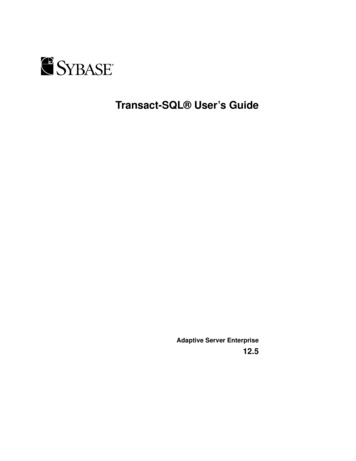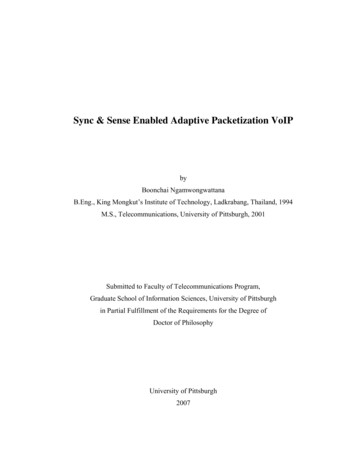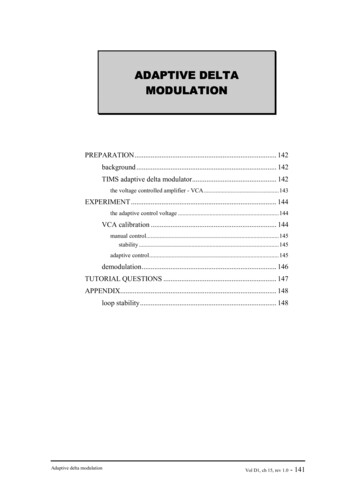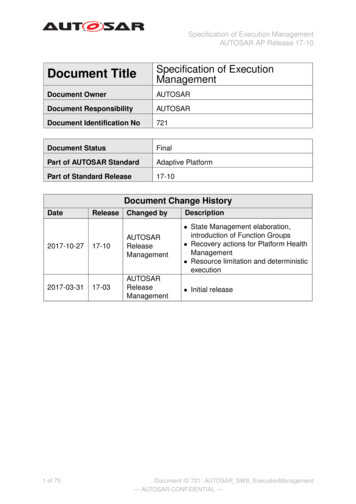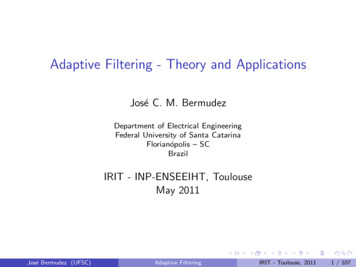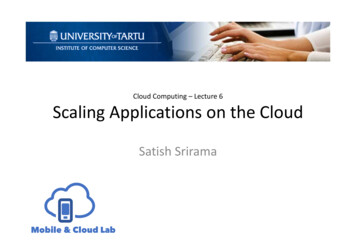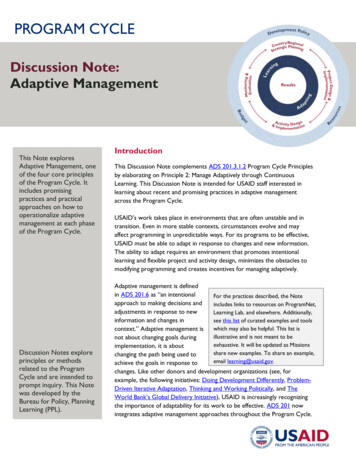
Transcription
PROGRAM CYCLEDiscussion Note:Adaptive ManagementThis Note exploresAdaptive Management, oneof the four core principlesof the Program Cycle. Itincludes promisingpractices and practicalapproaches on how tooperationalize adaptivemanagement at each phaseof the Program Cycle.Discussion Notes exploreprinciples or methodsrelated to the ProgramCycle and are intended toprompt inquiry. This Notewas developed by theBureau for Policy, PlanningLearning (PPL).IntroductionThis Discussion Note complements ADS 201.3.1.2 Program Cycle Principlesby elaborating on Principle 2: Manage Adaptively through ContinuousLearning. This Discussion Note is intended for USAID staff interested inlearning about recent and promising practices in adaptive managementacross the Program Cycle.USAID’s work takes place in environments that are often unstable and intransition. Even in more stable contexts, circumstances evolve and mayaffect programming in unpredictable ways. For its programs to be effective,USAID must be able to adapt in response to changes and new information.The ability to adapt requires an environment that promotes intentionallearning and flexible project and activity design, minimizes the obstacles tomodifying programming and creates incentives for managing adaptively.Adaptive management is definedin ADS 201.6 as “an intentionalFor the practices described, the Noteapproach to making decisions andincludes links to resources on ProgramNet,adjustments in response to newLearning Lab, and elsewhere. Additionally,information and changes insee this list of curated examples and toolswhich may also be helpful. This list iscontext.” Adaptive management isillustrative and is not meant to benot about changing goals duringexhaustive. It will be updated as Missionsimplementation, it is aboutshare new examples. To share an example,changing the path being used toemail learning@usaid.gov.achieve the goals in response tochanges. Like other donors and development organizations (see, forexample, the following initiatives: Doing Development Differently, ProblemDriven Iterative Adaptation, Thinking and Working Politically, and TheWorld Bank’s Global Delivery Initiative), USAID is increasingly recognizingthe importance of adaptability for its work to be effective. ADS 201 nowintegrates adaptive management approaches throughout the Program Cycle.
“Manage adaptively through continuous learning” is one of the four core principles that serve as thefoundation for Program Cycle implementation.DefinitionThis Discussion Note is organized around the phases of theAdaptive management is anProgram Cycle (strategy, project, and activity design andintentional approach to makingimplementation; monitoring and evaluation; and learning anddecisions and adjustments inadapting); While the adaptive management approaches describedresponse to new informationhere are examples of initial entry points associated with a specificand changes in context.phase of the Program Cycle, many of these approaches lead toadjustment in other areas. The note concludes with sections on enabling conditions and a description ofthe skills and attributes of adaptive managers.Adaptive Management in the Program CycleSTRATEGIC PLANNING AND IMPLEMENTATIONAs Missions develop and implement Country Development Cooperation Strategies (CDCSs), USAIDundertakes analyses and assessments; implements projects; participates in learning activities, such asstocktaking exercises and portfolio reviews; engages stakeholders; and analyzes and uses monitoring andevaluation information. The knowledge and learning gained by these and other activities should be usedto adaptively manage the strategy. To facilitate adaptability in strategic planning and implementation,approaches to consider include: Incorporate Scenario Planning to Enable Flexibility: Some Missions have built scenarioplanning into the process of designing strategies. Systematically examining a range of possibilitiesin a given country or region enables the Agency to address the range of contextual changes thatmay occur in the course of strategy implementation. The focus of scenario planning is toanticipate, track, and prepare for changes in the context that might occur duringimplementation. For more information, see the Scenario Planning page on ProgramNet. Use Learning and Reflection Opportunities: To facilitate adaptive management duringimplementation of a strategy, Missions use strategy-level portfolio reviews and CDCS midcourse stocktakings to assess how project results are contributing to achievement ofIntermediate Results and progress toward Development Objectives, and/or if the country hasmoved from one scenario to another. These events are an opportunity to revalidate thestrategic overall approach, check assumptions, revisit scenarios, engage stakeholders, and then, ifneeded, adapt the strategy based on new information and lessons learned. Create and Use a CDCS CLA (Collaborating, Learning and Adapting) Plan: TheMonitoring, Evaluation and Learning (MEL) section of the CDCS is a preliminary explanation ofthe Mission’s planned approach to MEL during strategy implementation. The PerformanceManagement Plan includes a CLA plan that captures the details of how and when this work isdone, analyzed, and applied. These plans outline actions that enable adaptation such as: settingforth the analytic agenda for the life of the strategy; explaining the approach to analyzing andusing context and performance monitoring and evaluation findings; defining learning agendaquestions; and describing how the Mission will collaborate with partners to provide up to dateinformation that enables adaptation.VERSION 1 / JANUARY 2018PAGE 2
Documenting Adaptations to the Strategy: If the strategy’s learning and reflectionactivities lead to decisions to amend or update strategies or projects, Missions are required tofollow ADS 201.3.2.19 requirements for amending or updating a CDCS. Triggers for adjusting aCDCS include, but are not limited to: (1) changes in country context that prompt major shifts inprogramming; (2) internal changes in funding or Agency policy priorities that call for a rescopingor revision of intended results; and/or (3) recommended changes to the developmenthypothesis revealed through monitoring, evaluation and/or learning during the course ofimplementation.PROJECT DESIGN AND IMPLEMENTATIONProject design is defined in ADS 201.3.3 as “the process by which USAID defines how it willoperationalize a result or set of results in a CDCS or other strategic framework to ensure that effortsare complementary and aligned in support of the strategy.” Building learning and flexibility into projectsduring the design process is critical. Managing projects adaptively during implementation allows ProjectTeams to react and adjust as necessary to ensure USAID is achieving its objectives.Some approaches to incorporating adaptability into the design process and during projectimplementation include: Understand Local Systems and Contexts: Context analysis is a required section of aProject Appraisal Document (PAD). Throughout the project design process and specificallyduring problem analysis, whether during development of the Project Design Plan or PAD, it isimportant to understand the local system and context, and equally important to understand thatthis context will inevitably change. Project Design Teams should focus on understanding theroot causes of the particular development problem and the role of actors and factors within thelocal system in addressing the problem. It is also essential to anticipate which context andcircumstances might necessitate course corrections. Develop a Complexity-Aware Theory of Change that Supports Adaptability andLearning: Based on understanding of the local system and context, the project description of aPAD describes the theory of change behind the proposed intervention. However, it is often thecase that assumptions regarding the conditions, behaviors, or critical events do not hold truethroughout the life of the project. To design a project that can be managed adaptively, it isrecommended that Project Teams use the PAD to: (1) articulate where there is uncertainty,either because the context is changing rapidly, or because additional analysis is needed, orbecause there are multiple variables that could potentially impact upon outcomes; (2) define theproblem in a manner that defines the higher-level outcomes that the project hopes to achieve,but also leaves lower-level outcomes undefined or illustrative to allow for iteration andadjustments during the design and implementation; and (3) establish a monitoring frameworkthat the team can use to assess the theory of change, revisit its underlying assumptions duringimplementation and make course corrections as necessary. See the How-To Note: Developing aProject Logic Model (and its Associated Theory of Change) for more on complexity as it relatesto logic models.VERSION 1 / JANUARY 2018PAGE 3
Hold Periodic Project Reviews to Assess Projects During Implementation: ADS201.3.3.14 recommends that Project Managers organize periodic project-level reviews, whichprovide an important opportunity to re-validate the theory of change underlying a project andassess whether or not all of the activities under a project are adding up to achieve the ProjectPurpose. If the results of activities are not adding up to the expected higher-level projectoutcomes, or if new information was made available, or the local context has changed in a waythat affects the project, teams should either adapt the project or individual activities asnecessary. Use the Project MEL Plan to Be Intentional about Learning During the ProjectDesign Process: USAID acknowledges that the Agency does not have perfect information atthe time of project design. This is why the learning questions developed as part of the ProjectMEL Plan are important: as they are answered, they provide updated information to informdecisions regarding adapting and making adjustments as changes occur. ADS 201 now requiresthat a learning section be included in the Project MEL Plan. Documenting Adaptation: ADS 201.3.3.14.C emphasizes the importance of learning andadapting at the project level, and provides a more customizable and streamlined approach toproject design as a whole. The guidance allows Mission management to customize designprocesses to fit unique circumstances, including depth of initial analyses and time scheduled tocomplete a PAD. Furthermore, ADS.201.3.3.16 now clarifies when PADs need to be formallyamended versus when an informal update would be suitable.ACTIVITY DESIGN AND MANAGEMENTAn activity, defined in ADS 201.3.4 as “an intervention or set of interventions, typically through animplementing mechanism such as a contract or assistance agreement,” should be designed to achieveclear and measurable results that contribute to a Project Purpose. They should also aim to strengthenlocal systems so that local actors continue to sustain key results after the activity ends. Because localsystems are constantly changing, it is critical to build learning and adaptability into the design andimplementation of activities in order for USAID programming to be successful.Activities should be designed with sufficient flexibility so that the path to implementation can be adjustedin response to emerging opportunities and knowledge. Regardless of which path or paths are ultimatelyused, USAID is accountable for achieving the stated objectives.Perhaps most importantly is the need for mutual trust between USAID and its implementing partners.Maintaining an open line of communication and jointly reassessing what is not working duringimplementation is a critical part of learning and adapting during activity implementation.Some key tactics to design and implement activities to facilitate adaptive management include: Outcome-Based Solicitations - Identify the what but not the how: Rather than explicitlydetermining specific technical approaches for implementing partners to use, activities can bedesigned to allow space for evolution and iteration over the course of implementation. SuchVERSION 1 / JANUARY 2018PAGE 4
designs describe the goals and desired outcomes and results. For more information, see Steps toPerformance Based Acquisition from the USAID OAA Business Manager’s Toolkit. Engage Contracting Officers/Agreement Officers (COs/AOs) early to identify amore flexible mechanism type, if appropriate: While all mechanism types can be designedto emphasize a more adaptive management approach, there are some implementing mechanismsthat are more flexible. Some examples include: hybrid contracts with an indefinite delivery,indefinite quantity (IDIQ) components embedded in the contract; single award IDIQs; phasedapproach/continuing application process for assistance; and incorporating scenarios intosolicitations or awards. For more information, see Shock Responsive Programming and AdaptiveMechanisms Guidance and USAID Procurement Executive’s Bulletin No. 2014-01.It is critical to include the CO/AO and Acquisition and Assistance (A&A) staff early on in theproject and activity design process so that they understand the goals and desired outcomes. Inaddition to their central role in instrument selection, their input is needed to incorporateadaptive management language and requirements into the relevant sections of solicitationdocuments which include independent government cost estimates, evaluation criteria,instructions to offerers, and proposal submission requirements. Including required indicators with targets within assistance and acquisitionagreements limits flexibility. Instead, leave room for the technical approach to achievingresults to evolve during implementation based on lessons learned and/or changes in countrycontext. Indicators and targets should be articulated in the Activity MEL Plan. Build in “pause and reflect” opportunities with implementing partners duringactivity implementation: In order to build a relationship with implementing partners basedon trust and communication, it is critical to plan for and engage in regular opportunities forpartners to reflect on progress. These “pause and reflect” opportunities could include partnermeetings, joint workplanning sessions among partners, portfolio reviews, and after-actionreviews. These opportunities may focus on challenges and successes in implementation to date,changes in the operating environment or context that could affect programming, opportunitiesto better collaborate or influence other actors, and/or other relevant topics. Since thesecollaboration efforts often require funding, it is important to build these into the activity’sbudget during activity design. Use routine workplanning to change course when necessary: There is a lot of room forflexibility during activity implementation. Using the activity’s annual or semi-annual workplan as amanagement tool to avoid multiple and lengthy contract or agreement modifications. Speak withthe CO/AO about how to best use the workplan process to refine the activity’s keyinterventions on a regular basis based on learning from implementation.MONITORING, EVALUATION, AND LEARNING FOR ADAPTIVE MANAGEMENTTo manage adaptively, USAID staff need high quality, timely data from monitoring and evaluations.Without appropriate data, staff may make changes too quickly, too late, or based on inaccurateinformation, resulting in interventions that are less rather than more effective. Optimizing MEL foradaptive management is an emerging field, and this section outlines several promising practices fromrecent USAID cases.VERSION 1 / JANUARY 2018PAGE 5
MEL for adaptive management expands upon themonitoring, evaluation and learning practices alreadyused as part of USAID’s Program Cycle. Anticipatingchanges in context and planning for course correctionsrequires reframing or renewed focus in areas of MELwith which staff may be familiar. Elements of andapproaches to MEL that facilitate adaptability include: Fit for Purpose MEL: ADS 201 outlines theMEL requirements for USAID programming,including mandatory guidance on what must bemonitored and evaluated. The policy providessignificant discretion for USAID staff todetermine the design of MEL Plans, like creatingevaluation questions, customizing indicators,and experimenting with different tools andapproaches. A critical aspect of managingadaptively is understanding that different typesof adaptations are enabled by different MELapproaches and tools. Choosing the right MELapproach for adaptive management should bebased on the specific assumptions, risks, andcomplexity of programs and the environmentsthey operate in. Focus on using practicalapproaches that are realistically suited to thetime, budget, and data needs of the project oractivity.Examples: Determining MEL purposeand matching with the best toolExample 1: A governance activity is working in acountry with a rapidly changing political climate.Key MEL Purpose: Continually assess the theory ofchange to see if it maintains its validity. IllustrativeMEL Tool(s): Performance Monitoring; ContextMonitoring; Developmental EvaluationExample 2: An economic growth activity hasresults dependent on critical assumptions thatrecent USAID assessments have shown are startingto shift. Key MEL Purpose: Monitor criticalassumptions. Illustrative MEL Tool(s): ContextMonitoringExample 3: A countering violent extremismactivity is using an intervention model based on keyassumptions that were impossible to verify beforeimplementation began. Key MEL Purpose: Testtheory of change assumptions duringimplementation. Illustrative MEL Tool(s):Developmental Evaluation; Most Significant Change;Rapid Impact EvaluationNote: PPL does not endorse or promote a particular toolor approach over others, but provides these examplesand links to resources as an initial entry point forexploration.A first step for any adaptively managed MELPlan is achieving clarity of purpose in why MELis needed. At USAID, staff are used to thinkingabout the purpose of MEL as a means for telling if projects and activities are meeting objectives.But it can be more than that – MEL can tell us if the assumptions in a theory of change areholding true, if certain aspects of the implementation are contributing more to an objective thanothers, or if changes in context are impacting programming. Managers can also use informationprovided by MEL to identify unexpected changes to context, or unintended consequences ofimplementation, which may inform decisions about the future path of programming. Identifying apriority purpose or use for MEL provides significant clarity to then select which of the variedMEL tools should be used. USAID MEL contacts within technical teams, the Mission ProgramOffice, regional and technical bureaus, and the Bureau for Policy, Planning, and Learning (PPL)are valuable resources for helping to determine what tools are best suited for different MELneeds. Using MEL that is fit for purpose is good practice for all projects and activities, and it isparticularly important for adaptively managed ones. Additional resources include the Systemsand Complexity White Paper, and Complexity Aware Monitoring Discussion Note.VERSION 1 / JANUARY 2018PAGE 6
Participatory MEL: Understanding changes in the environment and how they influence theassumptions and designs that underlie USAID’s programming requires an acute understanding oflocal context. MEL at USAID should draw from local stakeholders, including implementingpartner staff and beneficiaries, for insights into the programming environment or howactivities/interventions are perceived by the local population. Feedback loops that helpstakeholders understand how their data and analysis are informing project and activity designsand changes can lead to stronger buy-in, and in turn, higher quality data, more robust analysis,and improved adaptation. Increase Use of Context Monitoring: Managing adaptively requires a shift from focusing onhow USAID programming is influencing the environment to how the environment is influencingUSAID programming. While USAID staff instinctively understand that projects and activities areaffected by their context, MEL Plans do not often reflect this fact. Context monitoring allowsUSAID staff to make sense of the larger environment surrounding projects and activities. Whenfaced with finite resources for MEL, the challenge is determining what elements of theenvironment, or context, are most valuable to monitor. Traditionally, the link between projectand activity design and monitoring has started and ended with identification of desired resultsand the use of indicators to monitor them. However, the process of defining assumptions, risks,and triggering events during development of logic models can be an initial entry point foridentifying the most critical elements for context monitoring.COLLABORATING, LEARNING, AND ADAPTING (CLA)Collaborating, Learning and Adapting (CLA) is USAID’s framework for operationalizing adaptivemanagement in the Program Cycle. CLA includes strategic collaboration and continuous learning foradaptive management and the conditions that enable these processes. The CLA framework (see below)illustrates the components of CLA. The adapting component of the CLA framework includes: Opportunities to pause and reflect: Learning from monitoring and evaluation, as well asother sources of information and knowledge, requires time to reflect. As this literature reviewshows, “purposeful reflection on one’s accumulated experience leads to greater learning.”USAID Missions that plan for and host a variety of reflection opportunities should be better ableto reflect on and distill learning, and use that information to make decisions. Reflectionopportunities can take a number of forms, and ADS 201 requires several, including portfolioreviews and CDCS mid-course stocktaking exercises. Others are recommended, includingproject reviews, partner meetings, and after-action reviews. The sources for learning duringthese sessions may also be varied, including monitoring data and evaluation findings, as well asresearch, assessments, and knowledge gained from experience. Following through with changes: Adaptive management involves using learning to makechanges. This may mean working with implementing partners to change interventions, updatingan activity’s work plan, increasing or discontinuing the use of certain approaches or processes,reconfiguring staffing patterns, or modifying key Program Cycle documents, among otherchanges. When learning and knowledge are used to inform decision-making, those decisionsshould be followed through with action.VERSION 1 / JANUARY 2018PAGE 7
ENABLING CONDITIONSAdaptive management practices are much more likely to thrive in organizations with the right enablingconditions; conversely, staff will find it difficult to manage adaptively in an organization or team without asupportive environment. As such, considering the organization’s enabling conditions, and working toaddress the ‘disabling’ elements is critical for the adoption of adaptive management.USAID’s Collaborating, Learning and Adapting (CLA) framework defines three components of theenabling environment that support continuous learning and adaptive management: culture, processes andresources.VERSION 1 / JANUARY 2018PAGE 8
Organizational culture. An organization's culture consists of norms – often unwritten andunspoken – that influence how individuals work and what they expect of themselves and theircolleagues. Organizational culture is observable through staff and leaders’ behavior, how peopleinteract, and what is perceived to be encouraged and rewarded in the organization. The CLAframework identifies three elements of organizational culture: Openness. In a culture that values openness, staff at all levels are able to ask difficultquestions or express unpopular viewpoints, to invite alternative perspectives, and arewilling to explore new or untested ideas. Relationships and networks. Staff have relationships, among themselves and with outsidenetworks, that are based on trust. They value and prioritize communicating withstakeholders in a transparent way, and they are politically smart – using their networksto stay connected and aware of important developments. Continuous learning and improvement. In an organization that values continuous learning,staff are motivated to learn, both for professional growth and to contribute toorganizational effectiveness. Leaders enable participation in learning opportunities andencourage a focus on continuous improvement.Processes. Without supportive systems and processes in place, it is difficult for continuouslearning and adaptive management to become established in an organization. The CLAframework considers three aspects of an organization’s processes – decision-making, knowledgemanagement, and institutional memory – two of which are particularly critical for adaptivemanagement: Decision-making. In an organization in which decision-making processes that supportadaptive management are transparent; i.e., staff and stakeholders are aware of howdecisions are made in an organization. Stakeholder input is solicited before decisions aremade, and the results are documented and shared.It is also critical that decision-making authority be distributed throughout theorganization. In order to respond to changes in the context or during implementation,staff must have the appropriate level of authority to make decisions. Literature showsthat organizations with rigid and hierarchical decision-making processes are less likely tohave a learning culture that enables adaptive management. Knowledge management. Knowledge management involves using and sharing informationfrom a variety of sources. During planning and in implementation, staff should seek outknowledge and information from a variety of sources, including technical andexperiential knowledge, to inform decisions. Knowledge that is gained from work shouldbe shared, in a user-friendly format, to assist and influence others.Resources. Like most organizational initiatives, adaptive management needs to be supportedwith adequate resources in order to be sustainable. Resources that support adaptivemanagement include budget, staff, and implementing mechanisms. As discussed in the sectionbelow, adaptive management is an approach exhibited by individuals’ behaviors and attitudes.Organizations and teams can encourage and recognize their staff for working to build thesebehaviors and skills, and – when hiring – look to identify potential staff with the skills andVERSION 1 / JANUARY 2018PAGE 9
attributes of adaptive managers. Organizations also enable adaptive management by providingthe budget and resources, including time, needed to undertake the processes and activitiesdescribed in the strategy, project, and activity sections above.For more information and resources on Collaborating, Learning and Adapting and enabling conditions,see the CLA Toolkit.SKILLS AND ATTRIBUTES OF AN ADAPTIVE MANAGERIn addition to being impacted by the organizational context, adaptive management is an approachpracticed by individuals and exhibited by their behaviors and attitudes. Whether in the role of atechnical office director, Project Manager, Contracting Officer/Agreement Officer, Contracting Officer’sRepresentative/Agreement Officer’s Representative, team lead, Program Officer, Mission Director, orany other Mission role, staff with adaptive management qualities exhibit certain skills and attributes.These include but are not limited to: Curiosity. Adaptation comes more naturally to staff who have a strong interest in learningabout whether their work is achieving the results it set out to achieve, and who have aninclination toward action-oriented reflection.1 Communication and listening skills. Listening and transparent communication are critical tofacilitating a culture of openness and respectful dissent.2 Effective communicators not only listenwith attention and respect, but also actively seek input from peers and stakeholders to developa better understanding of the context and people involved in programming. Critical thinking. Adaptations should be based on data and evidence, not on a whim. Adaptivemanagers should be able to critically review, understand, and use information to make decisionsand carry out actions based on those decisions. Comfort with uncertainty and change. Adaptive management requires comfort withuncertainty, flexibility to change, and the humility to admit what one does not know or whenthings have not worked as expected.As USAID strengthens its focus on adaptive management, these skills and attributes should be taken intoaccount in recruitment and management decisions for USAID and implementing partners. While thesequalities come naturally to some individuals, for others, developing them may require particularattention and practice, coaching or other capacity strengthening. By valuing and investing in thedevelopment of these skills, USAID and development organizations will enable the adaptive managementpractices that are becoming increasingly necessary.VERSION 1 / JANUARY 2018PAGE 10
END NOTES1. “Adaptive Management: What It Means for CSOs”. Bond, 2016.2. “Navigating complexity: adaptive management and organizational learning in a development project inNorthern Uganda.” Allana and Sparkman. Knowledge Management for Development Journal 10(3). 2014.VERSION 1 / JANUARY 2018PAGE 11
operationalize adaptive management at each phase of the Program Cycle. Discussion Notes explore principles or methods related to the Program Cycle and are intended to prompt inquiry. This Note was developed by the Bureau for Policy, Planning Learning (PPL). Discussion Note: Adaptive Management PROGRAM CYCLE For the practices described, the Note
